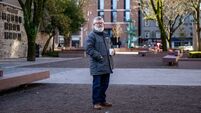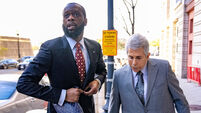Peace bandwagon should pick up many more deserving passengers
I know it’s the 10th anniversary of the Good Friday Agreement and I know that Bertie Ahern and Tony Blair deserve full credit for their part in bringing it to a conclusion. And I don’t for a moment begrudge either of them the honours that have been bestowed on them.
But they were never alone. The Good Friday Agreement itself was not exactly a standalone event, but the culmination of a process that had many milestones. Each of those milestones represented a significant increment on the road to peace and progress.
And yet I don’t remember 10th anniversary celebrations for the Anglo-Irish Agreement or the Downing Street Declaration or the Joint Framework Documents. I don’t see the likes of Garret FitzGerald, John Bruton, Peter Barry, Albert Reynolds and Dick Spring ever being invited to the events at which the peacemakers are honoured as indispensable and heroic.
Apart from the Good Friday Agreement, the only other event along the way that seems to benefit from sponsored celebrations and anniversaries is the IRA ceasefire. Of course the IRA decision to stop shooting and bombing people, after 30 years of sometimes horrible and cold-blooded atrocity, was welcome and historic in its own terms.
But the anniversary of that decision is never allowed to pass without comment on the courage and sacrifice of the volunteers and the bravery and determination of the leadership in committing itself to peaceful and democratic means.
I have to admit every time I see the propaganda use of that ceasefire in action, to paint a subliminal picture of frustrated peacemakers waiting for their moment to bring peace to Ireland, it sends a chill through my heart.
Because I remember Warrington. I remember Enniskillen. I remember Shankill. I remember a peace process that went on despite the atrocities. That peace process was often a lonely business which had to be conducted away from the cold light of day. Perhaps that’s why it isn’t celebrated so much nowadays.
Or maybe there are things about what happened back then that are a bit uncomfortable to remember. When Garret FitzGerald was doing his utmost to deal with the intransigence of Margaret Thatcher, for instance, the bipartisan approach that became a feature of the peace process was noticeably absent. FitzGerald was pilloried by the Fianna Fáil opposition in the aftermath of Thatcher’s famous “out, out, out” speech, and was roundly mocked when he determined to press ahead.
And when he did achieve the breakthrough and persuaded Thatcher to sign the Anglo-Irish Agreement in Hillsborough Castle (with Ian Paisley bellowing at the gate and the IRA leadership planning more murder), he was utterly opposed at home.
Charles Haughey’s first reaction was to send his Foreign Affairs spokesperson, Brian Lenihan, to the US to try to persuade leaders and public opinion there that the Anglo-Irish Agreement was a sellout. Indeed, in his own contribution to the debate on the Anglo-Irish Agreement in the Dáil, Bertie Ahern described it as a fundamental threat to Irish sovereignty and went on to say that in negotiating it, the government of the day “have wantonly squandered our deepest aspirations”.
Of course, many years later (and perhaps somewhat wiser) Bertie Ahern described the Anglo-Irish Agreement as “a shaft of light at a time of despair with no end to the violence in sight”.
Albert Reynolds’s principal objective as a peacemaker was to end the violence and thereby enable negotiation and discussion to begin. He was of course hugely successful in ending the violence, but not without taking his own risks and often feeling very lonely in the process.
In pursuing his singular ambition of removing the violence from the conflict, Reynolds was forced into doing unpalatable things in the immediate aftermath of the Warrington bomb.
When Gerry Adams carried the coffin of the bomber who had committed the Shankill massacre, Reynolds believed the demands of peace obliged him to shrug his shoulders and refuse to condemn Adams. And when John Major told Reynolds he could never negotiate about a piece of paper that had Adams’s fingerprints on it, the then Taoiseach, in the interests of peace, disowned what was known as the Hume/Adams process and left John Hume feeling utterly isolated.
None of these were easy decisions at the time. Had any of them gone wrong, Reynolds would never have established a reputation as a peacemaker. But he made the calls, often alone, and it worked.
Dick Spring was his deputy in those years. He saw it as his job, as part of keeping violence out of the conflict, to help develop a template that could be used for longer lasting progress. Working with Reynolds, and subsequently with John Bruton, Spring negotiated the Joint Framework Document with Patrick Mayhew and John Major’s government. And he did so at a time when that was a minority British government relying heavily on unionist support. Bill Clinton described the Joint Framework Document at the time as “another significant step forward in the peace process”.
But it took several years more to get the talks under way largely because of the decommissioning issue which was eventually resolved with the help of a process also designed and proposed by Dick Spring (and it was that process that introduced George Mitchell to the peace arena).
BY THE time the Joint Framework Document developed into a real agenda, Albert Reynolds and John Major had moved on. Tony Blair and Bertie Ahern were now in charge with secure political majorities, huge public support and an enormous amount of groundwork done by those who went before.
Of course, historians will see things differently, and hopefully in a more fully-rounded way. I was lucky enough to have been involved at a number of different times in the entire process and to observe it in action. One thing that constantly amazes me about the tribute business is how many other people there are who deserve tribute but never get it.
Public servants like Sean O’Huiginn, Paddy Teahon, Dermot Gallagher, Noel Dorr, Tim Dalton — the craftsmen and drafters of the process. Priests like Alec Reid and others who even to this day can’t be mentioned in public. Dozens more men and women whose motivation from the very beginning was peace and a new, just, beginning.
And that’s just on the Irish side. In Britain and in the North there is a substantial list of people motivated by the same concerns. So maybe we could move on now. Maybe we could begin to recognise that peace is not the preserve of any one individual.
The peace process in Ireland has been a seamless struggle conducted by democrats on behalf of all of us. We should find a way to honour them all.















